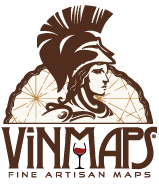From California to New York, there are a variety of wineries to be explored in America. As 4th of July celebrations approach, discovering the history of beautiful USA wine regions highlights a unique American tradition. Napa Valley is universally associated as the seminal American vineyard – however, a wealth of rich cultures and stories are to be found across the American wine industry. A brief history of winemaking in the U.S. heightens the depth of tradition of the practice, particularly in the early eras leading up to Prohibition.
The foundation of the first commercially successful winery stretches back to Cincinnati in the mid-1830s. Nicholas Longworth (1783-1863) was the founding father of winemaking in the U.S., after establishing vineyards among the hillsides of Cincinnati. Longworth’s technique involved cultivating sparkling wine from Catawba, a North American grape variety. His process of crafting the wine resembled the traditional method of wine production in the Champagne region of France. The wine industry in America by 1855 was flourishing in Midwestern states such as Ohio, Missouri, and Illinois. Longworth helped popularize American winemaking by shipping his product throughout the United States and Europe. By the mid nineteenth century, Ohio contained 1500 acres of vineyards, as well as over 1100 acres in Missouri and Illinois.
Prohibition & Ingenuity
After more than half a century of prosperity in the sphere of American winemaking, Prohibition was instituted in America on January 16, 1920. Winemakers faced a central dilemma with razing their vineyards or finding an alternative to using their grapes for alcohol production. The quandary of Prohibition deeply affected wine merchants in Napa Valley, who were central to the American wine industry prior to the alcohol embargo. The exhaustive decade–long effort of cultivating a vineyard spurred the Napa Valley vintners to produce their grapes into concentrated blocks of juice. Ingenuity essentially saved the vineyards of Napa Valley until prohibition was overturned.
Prohibition was instrumental in the prosperity and growth of the famed Beringer Vineyards. A flux in the market demand for concentrated grape juice surged during Prohibition, which propelled a myriad of investors and business men to California to seize the opportunity. In fact, the price per ton of grapes sky–rocketed from $9.50 to $375 after prohibition hit. Beringer was not the only prominent winery to benefit from the prohibition– Cesare Mondavi, the founder of Mondavi wine, relocated from Minnesota to California to capitalize on the thriving demand for grapes. The success stories of Beringer and Mondavi wines appeals to the spirit of America, since they relied on cleverness and fortitude to preserve the great American tradition of cultivating wine.
At VinMaps® we have been documenting the wine source since 2001. We’ve been honored to be part of shaping the wine experience for many customers through our collectible wine maps and resellers including Total Wine & More where we supply wine maps for their new wine education facilities.
